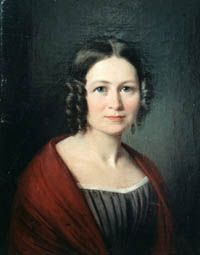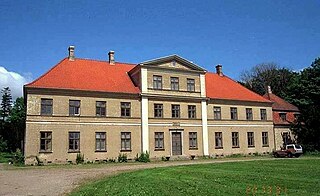
Frederick II was King of Denmark and Norway and Duke of Schleswig and Holstein from 1559 until his death in 1588.

Frederick V was King of Denmark and Norway and Duke of Schleswig-Holstein from 6 August 1746 until his death in 1766. A member of the House of Oldenburg, he was the son of Christian VI of Denmark and Sophie Magdalene of Brandenburg-Kulmbach.

Nikolaj Frederik Severin Grundtvig, most often referred to as N. F. S. Grundtvig, was a Danish pastor, author, poet, philosopher, historian, teacher and politician. He was one of the most influential people in Danish history, as his philosophy gave rise to a new form of nationalism in the last half of the 19th century. It was steeped in the national literature and supported by deep spirituality.

Assistens Cemetery in Copenhagen, Denmark, is the burial site of many Danish notables as well as an important greenspace in the Nørrebro district. Inaugurated in 1760, it was originally a burial site for the poor laid out to relieve the crowded graveyards inside the walled city, but during the Golden Age in the first half of the 19th century it became fashionable and many leading figures of the epoch, such as Hans Christian Andersen, Søren Kierkegaard, Christoffer Wilhelm Eckersberg, and Christen Købke are all buried here.
The Danish Golden Age covers a period of exceptional creative production in Denmark, especially during the first half of the 19th century. Although Copenhagen had suffered from fires, bombardment and national bankruptcy, the arts took on a new period of creativity catalysed by Romanticism from Germany. The period is probably most commonly associated with the Golden Age of Danish Painting from 1800 to around 1850 which encompasses the work of Christoffer Wilhelm Eckersberg and his students, including Wilhelm Bendz, Christen Købke, Martinus Rørbye, Constantin Hansen and Wilhelm Marstrand, as well as the sculpture of Bertel Thorvaldsen.

Frederik Ludvig Storch was a Danish genre painter.

Amalia Emma Sophie Hartmann née Zinn was a Danish composer who composed under the pseudonym Frederik H. Palmer. She was married to the composer Johan Peter Emilius Hartmann (1805–1900). They lived on the second floor in the Zinn House at Kvæsthusgade 3 in Copenhagen.

Nicolai Lumholtz was a Danish born, Norwegian clergyman. He served as acting bishop of the Diocese of Christiania.

Jacob Peter Mynster was a Danish theologian and clergy member of the Church of Denmark. He served as Bishop of the Diocese of Zealand from 1834 until his death.

Theobald Stein was a Danish sculptor. He was a professor at the Royal Danish Academy of Fine Arts and served as its director from 1883 to 1886.

the Güldencrone family, also spelled Guldencrone and Gyldenkrone, is a Danish and Norwegian noble family with the rank of fief baron.
Events from the year 1820 in Denmark.

Frederik Hansen Sødring was a Danish landscape painter and founder of an endowment.

The Jacob Holm House is a historic property located at Strandgade 4B in the Christianshavn neighbourhood of Copenhagen, Denmark. It was owned by the wealthy industrialist and shipowner Jacob Holm from 1819 to 1845. The building remained in the hands of the Holm family for more than 100 years. A plaque on the facade commemorates that N. F. S. Grundtvig was a tenant on the building.

The Danish Constituent Assembly is the name given to the 1848 Constitutional assembly at Christiansborg Palace in Copenhagen that approved the Danish Constitution and formalized the transition from absolute monarchy to constitutional democracy. It consisted of members of which 114 were elected by the people, 38 were appointed by the king and the rest were government ministers.

Sophie Wilhelmine Bertha Ørsted was a Danish socialite and muse. Brought up in a literary environment in Copenhagen, she was the sister of writer Adam Oehlenschläger (1779–1850) and was married to jurist Anders Sandøe Ørsted (1778-1860). She became an inspiration for others, including the poet Jens Baggesen (1764–1826). She died of abdominal complications when she was only 35.

Ole Bang was a Danish medical doctor and professor at the University of Copenhagen. He was a co-founder of Rosenborg Brøndanstalt. He was the paternal grandfather of author Herman Bang.
Niels (de) Bang was a Danish landowner. In 1809, he was awarded the Knight's Order of the Dannebrog for his efforts during the Battle of Copenhagen. He was the father-in-law of painter Frederik Sødring.
OlOluf Lundt Bang, also known as Ole Bang, was a Danish lawyer who ended his career as president of Hof- og Stadsretten. During the Struense affair, he served both as prosecutor in the trial against queen Caroline Matilda and as defence attorney in the trial against Enevold Brandt. In 1777, he was ennobled under the name de Bang. He was the father of playwright Baltsasar Bang and landowner Niels Bang.
















